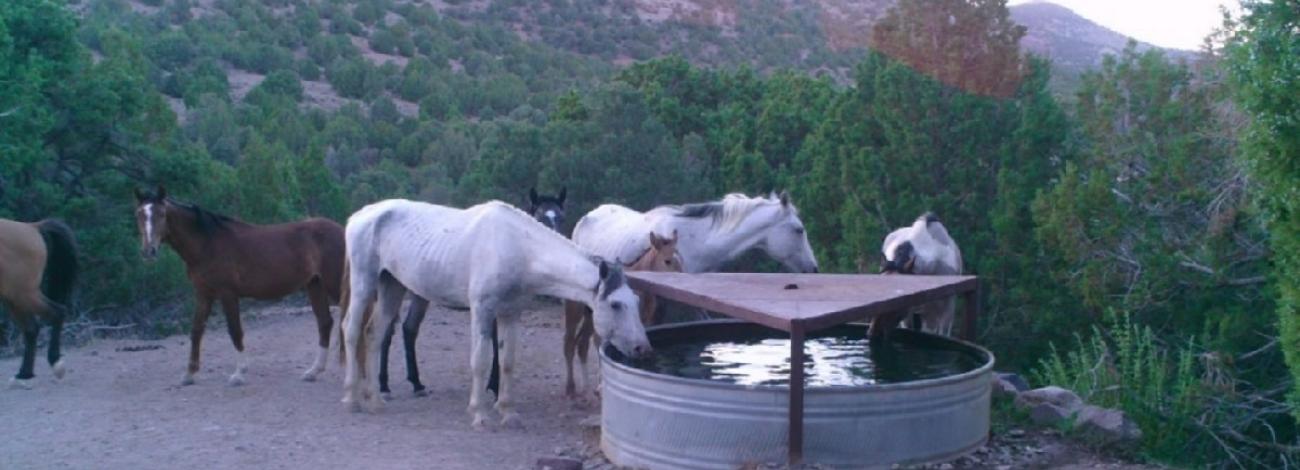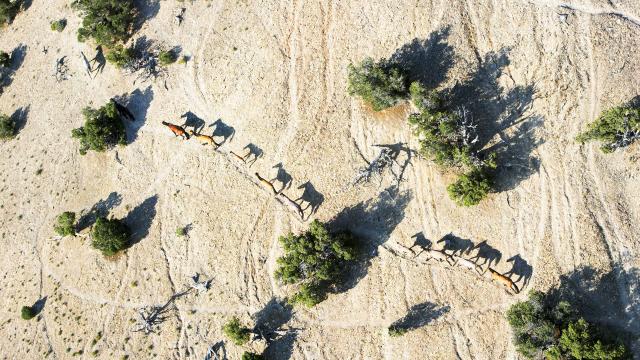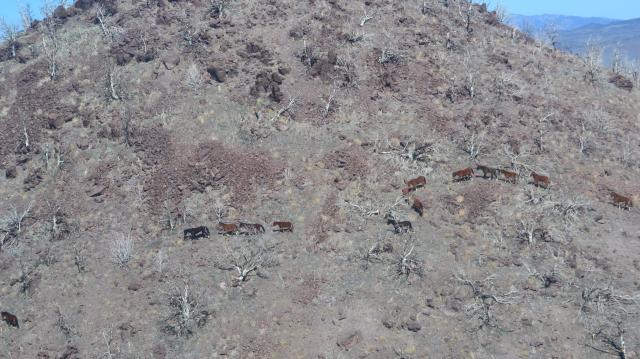
Science and Research
The BLM strives to apply the best available science as part of the agency’s efforts to ensure that self-sustaining populations of wild horses and burros can thrive on healthy public rangelands. For example, the BLM uses science to monitor rangeland vegetation, soils, water, wildlife habitat and the effects of wildfire. The BLM also relies on sound science and monitoring data to determine appropriate management levels for wild horse and burro herds. Although BLM has deep experience with resource monitoring, it is not a research agency – instead, BLM relies on the US Geological Survey (USGS), other federal agencies with research expertise, universities, and other partners to answer questions that are vital to wild horse and burro management.
2024 Request for Wild Horse and Burro Research Proposals
On November 1, 2024 the BLM released a new 'Request for Proposals' and 'Notice of Funding Opportunity' to solicit research proposals that address any of the priority research topics that were identified in the BLM Wild Horse and Burro Program 2021 Strategic Research Plan, and also summarized on this page. 'Attachment A' is a template for research proposal descriptions, and 'Attachment B' is a template for proposal budgets. The solicitations closed on Feb. 1, 2024 and the BLM is currently reviewing submitted proposals.
Fertility Control
The BLM's highest priority research topic remains the development of humane, safe, practical, and effective, long-lasting fertility control methods for mares. The sooner discoveries in fertility control research are made, the sooner the benefits of reduced growth rates can accrue in managed populations of wild horses. Currently available contraceptive vaccines have limitations that reduce their usefulness. Trials of promising new methods such as long-lasting vaccines, new intrauterine devices (IUDs), and minimally-invasive sterilization procedures could be highly informative.
The BLM has supported the development and testing of effective fertility control methods for wild horses and burros since 1978. To reduce overall herd growth rates, empirical studies and modeling confirm that a focus on reducing mare and jenny fertility is more effective than efforts to reduce stud or jack fertility. Over the years, research supported by BLM and other agencies has shown that some approaches – such as hormone implants or chemical vasectomies – are ineffective or impractical.
Currently the three most commonly used fertility control methods are all ‘immunocontraceptive’ vaccines. Porcine zona pellucida (PZP) vaccines and vaccines against gonadotropin-releasing hormone (GnRH), such as GonaCon, have been under development and testing since the 1990s. Two formulations of PZP vaccine are currently in use – Zonastat-H can be administered by hand-injection or by ground-darting, but is generally only effective for about one year. A single dose of the second PZP vaccine formulation, known as PZP-22, is marginally effective for 1-2 years but a second dose can lead to three years of infertility. BLM requires that PZP-22 be hand-injected into a captured wild horse. One dose of the GonaCon vaccine is marginally effective for 1-2 years, but recent BLM-supported research has shown that if a mare receives a second dose, she can be infertile for 4 or more years. As a result, the BLM has been increasing its use of Gonacon, using hand-injections or darting, where that is appropriate for local conditions. Longer-lasting methods that require fewer instances of handling or darting would help the BLM to reduce growth rates, and manage herds without the need for frequent gathers.
Environment and Climate Change
The BLM's second-highest research priority is to study relationships between wild horses and burros and their environment to inform BLM’s management. In an example of how research could inform BLM’s adaptation to climate change, predictions of future forage and water availability could inform local-level herd planning. Other research could reveal how variable herd density and resource availability might interact under future climate change. Research addressing wild horses and burros and their ecological context could also complement other BLM-supported research related to wildfire, wildlife, biodiversity conservation, restoration, and climate change.
Population Genetics, Surveys, and Other Research
There are other research topics that could benefit wild horse and burro management. For example, BLM’s management is already informed by the results of population genetic monitoring, where DNA from captured horses’ and burros’ hair follicles is amplified and analyzed. Laboratory results then reflect levels of genetic diversity in managed herds, and in some cases the high levels of interrelatedness between most managed herds. Results have shown that wild horses and burros in most BLM-managed herds are not truly isolated; they share ancestry with other herds, and often have recent or ongoing genetic interchange in the form of natural animal movements, or human-assisted translocations. Other wild horse genetic research has shown that DNA can be amplified from fresh horse dung; this approach to genetic monitoring could be useful in some small herds with population sizes that are close to the appropriate management level, where capture is impractical or unnecessary.
BLM’s management is also informed by the results of studies that document wild horse and burro ecology, behavior and demography, and improve survey methods. For example, recent studies documented wild horse ecological interactions with vegetation and Greater sage-grouse, and documented wild horse behaviors in bands either with or without fertility control treated individuals. Demographic research provides estimates of birth rates and death rates that are being used to update population models for wild horses. While no model is perfect, models can be useful to project the effects of different management scenarios, in terms of the expected population sizes and long-term costs of on-range and off-range management. USGS has helped BLM develop and test several methods for aerial surveys and ground surveys. BLM has applied these peer-reviewed survey methods in a widespread way since 2013.
Unsolicited Research Proposals
Researchers that want to submit an unsolicited proposal (one that is not responsive to any ‘Request for Proposals’) should see directions in the drop-down section below. Any research proposal that asks to involve federally protected wild horses and burros will be strictly scrutinized for animal safety and welfare, appropriateness, scientific merit, and fiscal responsibility.
- Instructions for Submitting Unsolicited Research Proposals / Non-RFP Proposals
-
Federal or Non-Federal researchers may submit Wild Horse and Burro Research Proposals for BLM review and consideration, even for proposed projects that are not responsive to any available ‘request for proposals.’ No BLM funding is set aside for such proposals, but the BLM does, on occasion, identify funding sources for particularly compelling, unsolicited wild horse and burro-related research proposals.
In keeping with BLM Policy, approval from the BLM Wild Horse and Burro Program Division Chief (HQ-260) is required for any research study related to BLM-administered Wild Horses and Burros, particularly if that research involves any handling of live wild horses or burros, any funding from the BLM, or any in-kind support from the BLM (such as any involvement of BLM personnel time). Unsolicited / non-RFP research proposals must include Attachment A and Attachment B, and be sent to the Wild Horse and Burro Program’s Research Coordinator ([email protected]) to begin the review process.Similarly, any request for the use of tissues, including DNA, from wild horses or burros for the purposes of research must be approved by the BLM Wild Horse and Burro Program Division Chief (HQ-260). Tissue requests will only be considered for the legitimate research that may benefit the management of wild horses and burros, or for which tissues from domestic equines cannot suffice. Any activities that could result in profit resulting from the use of wild horse and burro tissues is illegal and will not be considered. Requests must use the template for Wild Horse and Burro Applications for Tissue Request for Research, and must be sent to the program’s Research Coordinator ([email protected]) to begin the review process.
The review process for unsolicited wild horse and burro research proposals to the BLM Wild Horse and Burro Program, and for wild horse and burro tissue request applications to the BLM is as follows. Proposals are reviewed by the BLM Wild Horse and Burro Research Advisory Team. That team includes at least one BLM Wild Horse and Burro Specialist, the HQ-260 program’s On-range Branch Chief and Research Coordinator, the USDA APHIS Veterinary Services consulting Veterinarian, and may include liaisons from the US Forest Service and from the Wild Horse and Burro Advisory Board. For proposals beyond the expertise of the Research Advisory Team, external peer review(s) are solicited. The Research Advisory Team prepares recommendations to the Wild Horse and Burro Program Division Chief, who decides whether or not to approve or deny proposals and tissue request applications.
If a proposal is approved, funding decisions for unsolicited / non-RFP proposals are a separate matter and are as follows. No funding is guaranteed. Any funding decision would depend on the scientific quality of the research proposal, the proposed project’s responsiveness to identified priorities for research, the applicant’s eligibility for funding, the availability of funding, the logistical feasibility of the project, and the BLM’s decision to support the project. The funding mechanism would depend on the type of applicant. Cooperative agreements (also known as financial assistance agreements) are generally the type of instrument for non-federal researchers. For any cooperative agreement to be awarded, the BLM must prepare a ‘notice of funding opportunity’ that is open for at least 60 days to all eligible applicants may apply – in other words, the researcher that wrote the original proposal must still complete for that funding, if it is available. Interagency agreements are generally the type of instrument for funding research conducted by federal agency researchers.
Timing: Researchers proposing to work with federally protected wild horses and burros must plan on a very long lead time between the submission of any such proposal and their desired start of actual research activities. Researchers should plan on at least three (3) months to receive a decision about whether a proposal is approved or denied, after the time of proposal submission. Non-federal researchers should plan on another three to four (3-4) months from proposal approval to the formation of any cooperative agreement. The time to prepare an interagency agreement may be slightly shorter. The BLM may need to prepare National Environmental Policy Act (NEPA) analyses for research activities – this process can take over a year. The long time for NEPA analysis may require steps such as: the preparation of an draft Environmental Assessment; solicitation of public comments; response to and incorporation of public comments into a final Environmental Assessment and associated Finding of No Significant Impact and Record of Decision, where applicable. Further delays may be caused by administrative appeals or legal appeals.
Approved research will be monitored by the BLM. To retain funding and approval, researchers must abide by the terms of any agreement with the BLM related to the project.



